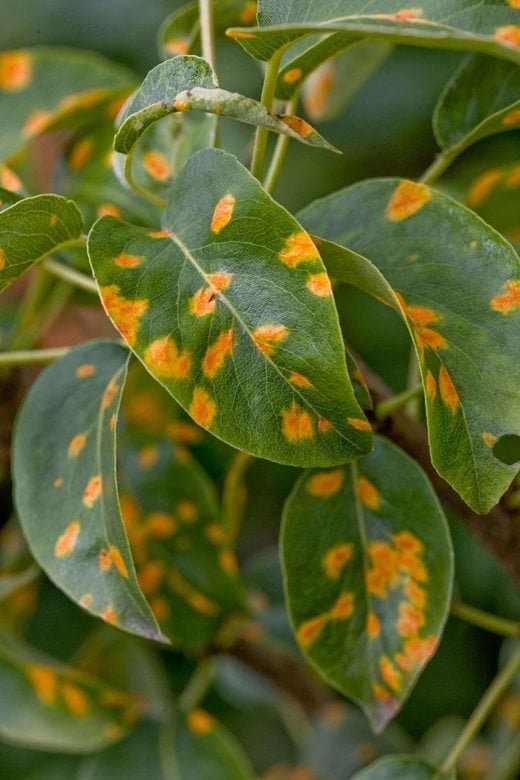 The changing climate will affect plant diseases already present, as well as those yet to arrive. Drier summers will mean a welcome decrease in downy mildews, leaf blights, fruit scabs and other diseases that require water to disperse their spores; tomato and potato blight and rose black spot, for example, all need water to complete their life cycles. Apple and pear scab also thrive in wetter weather. An exception is powdery mildew, which is able to infect even in dry conditions and can be severe on drought-stressed plants.
The changing climate will affect plant diseases already present, as well as those yet to arrive. Drier summers will mean a welcome decrease in downy mildews, leaf blights, fruit scabs and other diseases that require water to disperse their spores; tomato and potato blight and rose black spot, for example, all need water to complete their life cycles. Apple and pear scab also thrive in wetter weather. An exception is powdery mildew, which is able to infect even in dry conditions and can be severe on drought-stressed plants.
Phytophthora is giving horticulturists - and gardeners - cause for concern, due to predictions of wetter, warmer winters. While the best-known Phytophthora is potato leaf blight, it is unusual in being airborne because other species of this important pathogen group are soilborne and attack roots. They need water to infect and, like all pathogens, are limited by low temperatures. If winters become warmer, Phytophthora will have longer periods to infect. Work by scientist Clive Brasier and colleagues at Forest Research (the research agency of the Forestry Commission) gives unsettling predictions for the spread and severity of P. cinnamomi, an important species thought to originate in Asia.
Future disease problems
Athelia rolfsii
Among diseases that currently cannot quite establish, perhaps because our climate is too cool, is Athelia (formerly Corticium) rolfsii. This pathogen has a wide host range and is damaging in warmer climates such as southern USA.
Plants yellow and wilt, and develop rotting brown lesions at soil level. Its biology is similar to our indigenous Sclerotinia sclerotiorum, which does turn up in gardens and is an important pathogen of commercial crops such as lettuce, sunflower and oilseed rape.
It spends the dormant season as sclerotia, which are small, seed-like fungal structures that germinate in spring and can easily be spread accidentally on bulbs or in soil.
This disease already occurs in continental Europe and there have been outbreaks in the Channel Islands. It is close to making landfall in mainland Britain. There is one report that it did, in fact, cause serious damage to an experimental crop of imported bulbs in the UK, but the infection died out and has not recurred.
Canna viruses
Cannas are increasingly popular in the UK and a longer, warmer growing season will mean that they can be grown more widely.
However, with new plants come new problems. The 2002 RHS Plant Trial of cannas (for AGM award plants) was heavily infected with virus. Bean yellow mosaic virus was confirmed and a second one, Canna yellow mottle virus, was suspected. Some severely affected plants were rogued before planting out, but even so, at least 70% of the trial was affected.
Because cannas are vegetatively propagated, these viruses are easily spread in infected planting material. It will be important for gardeners and the retail trade to source healthy plants.
Camellia flower blight
This disease originates in Japan and is present in New Zealand, USA and much of mainland Europe. It was first detected in Cornwall in the 1990s. In 2002 it was reported more widely through southern England, and RHS pathologists detected it for the first time at RHS Garden Wisley, though it must have been present undetected for at least a year.
It is a major problem in the USA and threatens to become a problem in Britain. Little can be done to prevent its spread. As the northern limit for frost-sensitive species extends with a warming climate, the disease is likely to follow.
Pear rust
The laboratory at Wisley has noticed an upsurge in the frequency of pear rust (Gymnosporangium sabinae).
This striking disease was once a rarity in the UK, with none recorded in some years, but now our pathologists can sometimes see more than 30 cases a year.
Could this upsurge be due to climate change? As yet this is unknown, but the disease and climate seem to be associated.
Think you've found a new plant disease?
If you think you have found a new-to-Britain disease and are an RHS member, you can send or bring samples to the Members’ Advisory Service at RHS Garden Wisley, Woking, Surrey GU23 6QB, or contact the relevant plant health authority.
Send samples of the disease with the host plant in a sealed polythene bag in a stout container. In your covering letter give details of where the plant is being grown, from where it was obtained and when the problem was first noticed. Please provide a contact telephone number.

